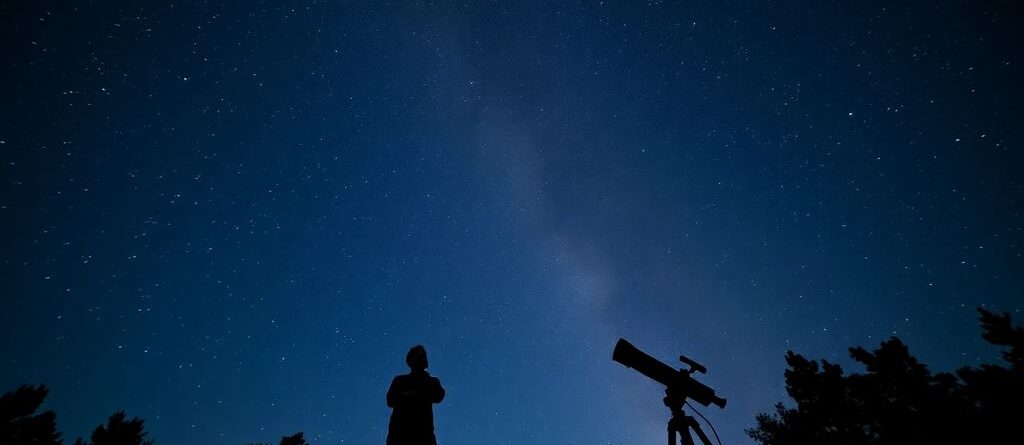Science
Amateur Astronomy Tips for Stargazing Enthusiasts

Stargazing is a fascinating hobby that invites people to explore the wonders of the night sky. Whether you’re gazing at stars, planets, or distant galaxies, there’s so much to discover. This guide offers essential tips for amateur astronomers, helping you to make the most of your stargazing experience.
Key Takeaways
- Start with binoculars before investing in a telescope.
- Learn to identify constellations with the naked eye.
- Dress appropriately for the weather when stargazing.
- Join local astronomy clubs for shared experiences and advice.
- Keep a diary of your observations to track your progress.
Choosing the Right Equipment for Amateur Astronomy
When starting your journey in amateur astronomy, selecting the right equipment is crucial. The choice between binoculars and telescopes can significantly affect your stargazing experience.
Binoculars vs. Telescopes
- Binoculars are portable and easy to use, making them great for beginners. They are perfect for observing the moon and star clusters.
- Telescopes offer more detail and are better for viewing planets and deep-sky objects. However, they can be bulky and require more setup.
- Consider your observing goals and how often you plan to use the equipment.
Essential Accessories for Stargazing
To enhance your stargazing experience, consider these essential accessories:
- Star charts or apps to help identify constellations.
- Red flashlight to preserve night vision.
- Comfortable chair for long observing sessions.
Buying Second-hand Astronomy Gear
Purchasing second-hand equipment can save you money. Here are some tips:
- Check for scratches or damage on lenses.
- Ensure the mount is stable and functions smoothly.
- Ask the seller about the history of the equipment.
Remember, the best telescope for beginners is the one you’ll use most often. Don’t rush; take your time to find the right fit for your needs.
In summary, whether you choose binoculars or a telescope, ensure you invest in quality equipment that suits your stargazing ambitions. Happy observing!
Understanding the Night Sky
Learning Constellations and Star Patterns
To truly enjoy stargazing, it’s essential to learn about constellations and the patterns they form. Here are some tips to get started:
- Begin with the basics: Start by identifying a few major constellations, such as Orion or Ursa Major.
- Use star charts: These can help you locate constellations in the night sky.
- Practise regularly: The more you observe, the easier it becomes to recognise patterns.
Using Star Charts and Planispheres
Star charts and planispheres are valuable tools for any stargazer. They help you understand the layout of the night sky. Here’s how to use them effectively:
- Choose the right chart: Select a chart that matches your location and the time of year.
- Align the chart: Hold the chart above your head, aligning it with the direction you are facing.
- Identify stars: Use the chart to find stars and constellations visible in your area.
Identifying Planets and Other Celestial Objects
Planets can often be seen with the naked eye, and they have unique characteristics that set them apart from stars. Here’s how to identify them:
- Look for brightness: Planets like Venus and Jupiter are usually brighter than most stars.
- Check their movement: Unlike stars, planets move against the background of stars over time.
- Use apps: There are many smartphone apps that can help you identify planets and other celestial objects in real-time.
Remember: Stargazing is not just about seeing; it’s about connecting with the universe. Take your time and enjoy the beauty of the night sky.
In summary, understanding the night sky involves learning about constellations, using star charts, and identifying planets. With practise, you’ll find that the sky is full of wonders waiting to be discovered!
Preparing for a Night of Stargazing
Stargazing can be a magical experience, but preparation is key to making the most of your night under the stars. Here are some essential tips to ensure you have a great time:
Dressing for the Weather
- Layer Up: Wear multiple layers to stay warm, as temperatures can drop at night.
- Comfortable Footwear: Choose shoes that are suitable for walking on uneven ground.
- Accessories: Don’t forget a hat and gloves to keep your extremities warm.
Setting Up Your Observing Site
- Choose a Dark Location: Find a spot away from city lights to reduce light pollution.
- Check for Hazards: Ensure the area is free from holes or obstacles that could cause you to trip.
- Bring a Chair: A comfortable chair can help you relax while you gaze at the sky.
Essential Items to Bring Along
- Star Charts or Apps: Use these to help identify constellations and celestial objects.
- Red Light Torch: This will help you see without ruining your night vision.
- Blanket or Mat: Perfect for lying down and enjoying the view.
Remember, the more you prepare, the more you can enjoy the wonders of the night sky. Take your time to adjust your eyes to the darkness; it can take about 20 minutes to see the faintest stars clearly.
By following these tips, you’ll be well on your way to a successful night of stargazing!
Improving Your Observational Skills
Dark Adaptation Techniques
To see the stars clearly, your eyes need to adjust to the darkness. Here are some tips to help you:
- Avoid bright lights before stargazing.
- Give your eyes time to adjust; it can take up to 30 minutes.
- Use red light for reading charts, as it doesn’t ruin your night vision.
Using Red Light for Night Vision
Using red light is essential for maintaining your night vision. Here’s how to do it effectively:
- Use a red flashlight or cover a regular flashlight with red cellophane.
- Limit the time you use any light source.
- Keep your eyes focused on the stars as much as possible.
Keeping an Astronomy Diary
Keeping a record of your observations can enhance your experience. Here’s why:
- Track your progress and see how your skills improve.
- Record details like date, time, and what you observed.
- Reflect on your experiences to deepen your understanding of the night sky.
Keeping a diary can help you remember your early experiences and sightings, making your journey in astronomy more meaningful.
Summary
Improving your observational skills is about patience and practise. By using techniques like dark adaptation and keeping a diary, you can enhance your stargazing experience. Remember, the more you observe, the more you will learn about the wonders of the universe!
Joining the Astronomy Community
Finding Local Astronomy Clubs
Joining a local astronomy club can be a fantastic way to meet fellow stargazers. These clubs often host events where you can learn from experienced astronomers. Here are some benefits of joining:
- Access to telescopes and equipment
- Opportunities to attend star parties
- A chance to make new friends who share your passion
Attending Star Parties
Star parties are gatherings where astronomy enthusiasts come together to observe the night sky. They are a great way to:
- Try out different telescopes
- Learn new skills from others
- Share your own experiences and discoveries
Participating in Online Astronomy Forums
If you can’t find a local club, online forums can be a great alternative. Here, you can:
- Ask questions and get advice from experienced astronomers
- Share your observations and photos
- Connect with people from around the world who share your interests
Joining a community can greatly enhance your stargazing experience. It’s not just about the stars; it’s about the friendships and knowledge you gain along the way.
By engaging with others, you can deepen your understanding of the cosmos and enjoy your hobby even more!
Making the Most of Your Observing Sessions
Planning Your Observations
To truly enjoy your stargazing experience, planning is key. Here are some steps to help you prepare:
- Check the Weather: Ensure the night is clear and free from clouds.
- Know What to Look For: Research celestial events or specific objects you want to observe.
- Set a Time: Choose a time when the sky is darkest, usually after sunset.
Recording Your Observations
Keeping a record of your stargazing sessions can enhance your experience. Consider these tips:
- Use a notebook to jot down what you see, including dates and times.
- Note any interesting details, like the brightness of stars or the visibility of planets.
- Review your notes to track your progress and discoveries.
Sharing Your Discoveries
Sharing your experiences can be rewarding. Here’s how:
- Join local astronomy clubs to meet fellow enthusiasts.
- Attend star parties to share your findings and learn from others.
- Use social media or online forums to showcase your observations and connect with a wider community.
Keeping an astronomy diary can deepen your connection to the night sky. It allows you to reflect on your journey and appreciate the beauty of the universe.
By following these steps, you can truly make the most out of your observing sessions and enjoy the wonders of the night sky!
Exploring Deep-Sky Objects
Observing Nebulae and Galaxies
Deep-sky objects like nebulae and galaxies are some of the most fascinating sights in the night sky. Here are a few tips to help you observe them:
- Use binoculars or a telescope for better visibility.
- Find a dark location away from city lights.
- Be patient; some objects may take time to appear clearly.
Finding Star Clusters
Star clusters are groups of stars that are close together in space. To locate them:
- Start with a star chart to identify clusters in your area.
- Use binoculars to scan the sky for fuzzy patches.
- Focus your telescope on these patches to reveal the stars.
| Type of Cluster | Example | Visibility |
|---|---|---|
| Open Cluster | Pleiades | Easy |
| Globular Cluster | Omega Centauri | Moderate |
Using Philtres to Enhance Views
Philtres can improve your view of deep-sky objects. Here’s how to use them:
- Choose the right philtre for the object you’re observing (e.g., a nebula philtre for nebulae).
- Attach the philtre to your eyepiece before observing.
- Experiment with different philtres to see which gives the best view.
Observing deep-sky objects can be a magical experience. Take your time and enjoy the beauty of the universe!
Astrophotography for Beginners
Choosing the Right Camera
When starting with astrophotography, selecting the right camera is crucial. Here are some options:
- DSLR Cameras: Great for beginners, versatile, and can be used for various photography styles.
- Mirrorless Cameras: Compact and lightweight, ideal for long exposures.
- Smartphone Cameras: Convenient and easy to use, but may require additional accessories for better results.
Basic Astrophotography Techniques
To capture stunning images of the night sky, consider these techniques:
- Use Manual or Bulb Mode: This allows for longer exposure times, essential for capturing faint stars.
- Fast Aperture: Aim for an aperture of f/2.8 to f/4 to let in more light.
- Set Exposure Length: A good range is between 15-30 seconds to avoid star trails.
Editing and Sharing Your Photos
After capturing your images, editing can enhance their beauty. Here are some tips:
- Use software like Adobe Lightroom or Photoshop for adjustments.
- Share your work on social media or astronomy forums to connect with other enthusiasts.
- Consider printing your best shots to showcase your talent.
Astrophotography is not just about the gear; it’s about patience and practise. The more you shoot, the better you’ll get!
Educational Resources for Amateur Astronomers

Recommended Books and Magazines
One of the best ways to learn about astronomy is through books and magazines. Here are some top picks:
- Nightwatch: A Practical Guide to Viewing the Universe by Terence Dickinson
- The Backyard Astronomer’s Guide by Terence Dickinson and Alan Dyer
- Sky & Telescope magazine for monthly sky maps and observing tips.
Useful Websites and Apps
The internet is a treasure trove of information. Here are some useful resources:
- SkyTonight.com – Offers equipment reviews and observing tools.
- NASA’s website – Great for learning about current missions and discoveries.
- Stellarium – A free planetarium software that shows the night sky in real-time.
Taking Astronomy Courses
Consider enrolling in a course to deepen your understanding. Many community colleges and online platforms offer classes. Here are some options:
- Local community college astronomy courses
- Online platforms like Coursera or Udemy
- Workshops at local observatories or planetariums
Remember, the more you learn, the more you will enjoy your stargazing experiences.
By exploring these resources, you can enhance your knowledge and skills in amateur astronomy, making your stargazing sessions even more rewarding!
Safety Tips for Stargazing
Avoiding Light Pollution
To truly enjoy the night sky, it’s essential to find a dark location. Light pollution can significantly hinder your ability to see stars and celestial objects. Here are some tips to minimise its effects:
- Choose remote areas away from city lights.
- Visit state or national parks known for dark skies.
- Use a red light torch to preserve your night vision.
Staying Safe in Remote Locations
When stargazing in secluded areas, safety should be a priority. Consider the following:
- Inform someone about your location and expected return time.
- Bring a friend along for added safety.
- Carry a first-aid kit and know basic first-aid procedures.
Handling Equipment Properly
Proper handling of your stargazing gear is crucial to avoid accidents. Here are some guidelines:
- Always set up your equipment on stable ground to prevent falls.
- Keep your gear organised to avoid tripping hazards.
- Use a protective case for your binoculars or telescope when transporting them.
Remember, stargazing is not just about observing the sky; it’s also about enjoying the experience safely. Take the necessary precautions to ensure a pleasant night under the stars!
Seasonal Stargazing Tips
What to Observe in Different Seasons
Each season offers unique celestial sights. Here’s a quick guide:
- Spring: Look for the constellation Orion and the Pleiades star cluster.
- Summer: The Milky Way is prominent, and you can spot Scorpius.
- Autumn: Andromeda Galaxy becomes visible, along with the Great Square of Pegasus.
- Winter: Orion returns, and you can see the Gemini constellation.
Preparing for Seasonal Changes
As the seasons shift, so do the conditions for stargazing. Here are some tips:
- Check the weather: Clear skies are essential for good viewing.
- Dress appropriately: Layer your clothing to stay warm during chilly nights.
- Adjust your schedule: Different seasons mean different times for optimal viewing.
Special Events and Celestial Phenomena
Keep an eye out for these exciting events:
- Meteor showers: Such as the Perseids in August and the Geminids in December.
- Planetary alignments: These can create stunning views in the night sky.
- Eclipses: Both solar and lunar eclipses are spectacular sights not to be missed.
Stargazing is a wonderful way to connect with nature and the universe. Each season brings its own beauty, so be sure to explore the night sky throughout the year!
Final Thoughts on Stargazing
In conclusion, stargazing is a wonderful hobby that anyone can enjoy. By taking the time to learn about the night sky and using simple tools like binoculars or star charts, you can discover the beauty of the universe. Remember to connect with local astronomy clubs and share your experiences with friends and family. Keep a diary of your observations to track your progress and make your journey even more enjoyable. Most importantly, have fun and embrace the wonders of the cosmos. The night sky is waiting for you!
Frequently Asked Questions
What equipment do I need to start stargazing?
To begin stargazing, you can start with just your eyes. Binoculars are a great first step, and eventually, you might want to get a telescope for a closer look.
How do I learn about the constellations?
You can learn about constellations by using star charts, apps, or even books from your local library. Spending time outside at night will help you recognise them.
What is the best time to go stargazing?
The best time for stargazing is on clear nights, away from city lights. Late evenings and nights after sunset are ideal.
What should I wear while stargazing?
Dress warmly, as it can get chilly at night. Layering clothes is a good idea, and don’t forget a hat and gloves.
How can I improve my night vision for stargazing?
Give your eyes about 20 minutes to adjust to the darkness. Avoid looking at bright lights, and use a red light if you need to see something.
Is it safe to stargaze alone?
While stargazing alone can be peaceful, it’s safer to go with a friend or group, especially in remote areas.
Can I take pictures of the stars with my phone?
Yes, many smartphones have good cameras that can capture the night sky. There are also apps that can help you take better astrophotography.
How do I find local astronomy clubs?
You can search online for local astronomy clubs or check community boards. Joining a club is a great way to meet fellow stargazers and learn more.
-

 Press Release6 days ago
Press Release6 days agoNura Labs Files Revolutionary Patent: AI-Powered Wallet Solves the $180 Billion Crypto Staking Complexity Crisis
-

 Press Release4 days ago
Press Release4 days agoGlobal Compound Feeds and Additives Industry Report: Market Expansion and Competitive Insights to 2035
-

 Technology4 days ago
Technology4 days agoWhat to Know Before Switching Cell Phone Network Services in 2025
-

 Press Release3 days ago
Press Release3 days agoCrypto WINNAZ Launches First On-Chain Yield Engine for Meme Coins, Enabling 20x–300x Returns
-

 Press Release2 hours ago
Press Release2 hours agoBellarium ($BEL) Price Prediction: Could It Hit $5 by 2026?
-

 Press Release1 hour ago
Press Release1 hour agoWhy Alaxio (ALX) Is a Top Pick for Smart Crypto Investors












